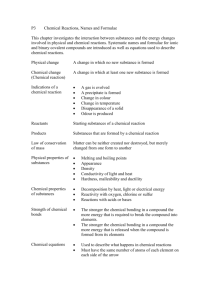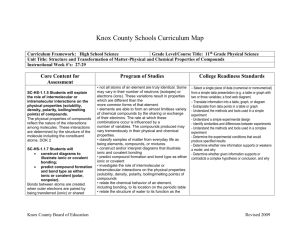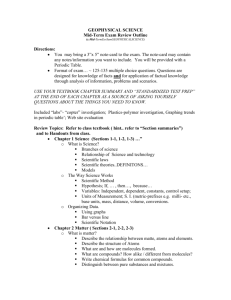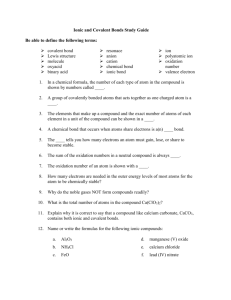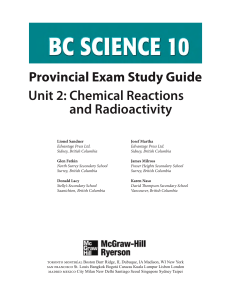ch 4 notes
advertisement
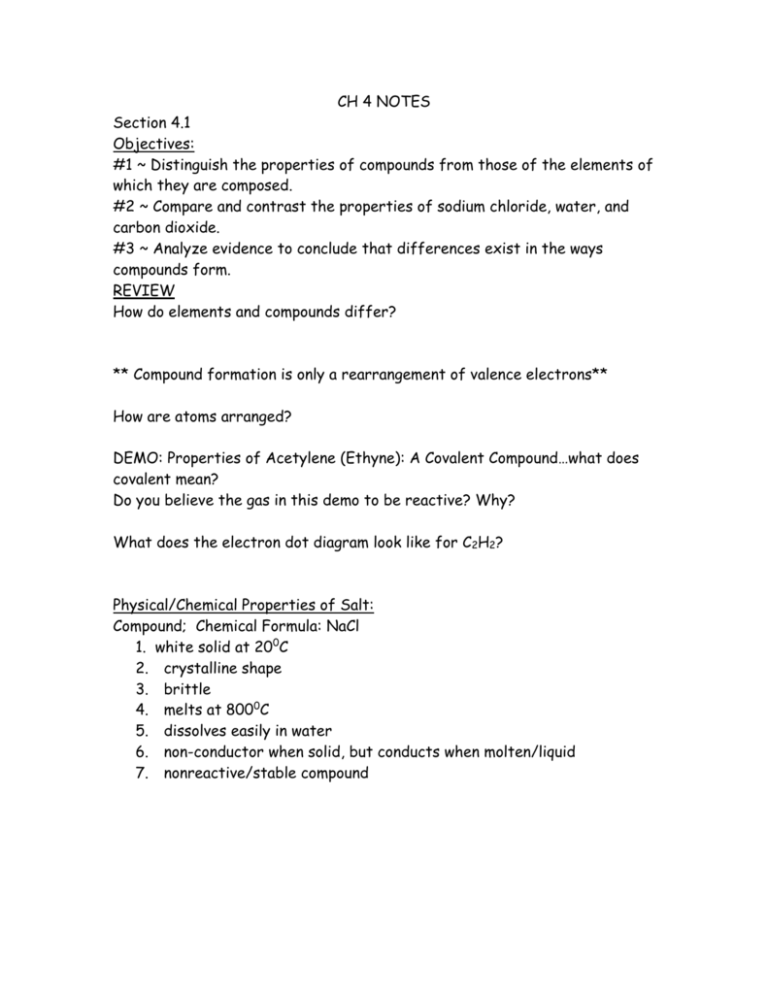
CH 4 NOTES Section 4.1 Objectives: #1 ~ Distinguish the properties of compounds from those of the elements of which they are composed. #2 ~ Compare and contrast the properties of sodium chloride, water, and carbon dioxide. #3 ~ Analyze evidence to conclude that differences exist in the ways compounds form. REVIEW How do elements and compounds differ? ** Compound formation is only a rearrangement of valence electrons** How are atoms arranged? DEMO: Properties of Acetylene (Ethyne): A Covalent Compound…what does covalent mean? Do you believe the gas in this demo to be reactive? Why? What does the electron dot diagram look like for C2H2? Physical/Chemical Properties of Salt: Compound; Chemical Formula: NaCl 1. white solid at 200C 2. crystalline shape 3. brittle 4. melts at 8000C 5. dissolves easily in water 6. non-conductor when solid, but conducts when molten/liquid 7. nonreactive/stable compound Properties of Sodium Element; Symbol: Na 1. shiny, silvery-white, soft solid at room temp 2. melts at 980C 3. reacts with oxygen to form sodium oxide, Na2O 4. reacts with water to form hydrogen gas, and sodium hydroxide, NaOH (this is why its pure form is stored in oil) 5. never found free in the environment b/c of its high reactivity Properties of Chlorine Element; Symbol: Cl2 (this is what’s called a diatomic element) 1. pale green, poisonous, gas @ room temp 2. odor 3. kills living cells, disinfects 4. boiling point is a mere –340C 5. among the most reactive elements Physical/Chemical Properties of Carbon Dioxide: Compound; Chemical Formula: CO2 1. colorless gas at room temp 2. slightly soluble in water 3. freezing point = -800C, DRY ICE 4. relatively stable; puts out fire 5. ingredient in photosynthesis 6. tasteless and odorless DEMO: How can you make Carbon Dioxide? Properties of Carbon Element; Symbol: C 1. fairly unreactive solid at room temp 2. at higher temps, will react with MANY elements 3. burns easily and is an excellent heat source 4. carbon compounds are the basis of all living things 5. black, brittle solid at room temperature Properties of Oxygen Element; Symbol: O2 1. colorless, odorless, tasteless 2. supports combustion (it is not flammable by itself) 3. slightly soluble in water 4. very reactive 5. 21% of air you breathe 6. most abundant element in the Earth’s crust; not found on its own DEMO: Properties of Oxygen Gas Physical/Chemical Properties of Water Compound; Chemical Formula: H2O 1. gas at 1000C 2. solid at 00C 3. non-conductor (when distilled or pure) 4. great solvent 5. stable 6. good medium for other reactions to occur in 7. other ingredient in photosynthesis Properties of Hydrogen: What are they? Know at least 4 properties! Element; Symbol: H2 Extra Credit Questions: Problem 1: What causes the jet aircraft trails we see in the atmosphere? Problem 2: How would you use the different properties of salt, carbon dioxide, and water to separate the components of a carbonated, aqueous salt solution in a closed, pressurized bottle? Problem 3: If salt, carbon dioxide and water are all compounds, why are they so different? DEMO: A Metal and a Nonmetal React Section 4.2 Objectives: #1 ~ Model two types of compound formation: ionic and covalent at the atomic level. #2 ~ Demonstrate how and why atoms achieve chemical stability by bonding. #3 ~ Compare, using examples the effect of covalent and ionic bonding on the physical properties of compounds. The Octet Rule model of chemical stability based on the arrangement of valence electrons in noble gases this arrangement is called the noble gas configuration states that atoms can become stable by having 8 electrons in their outer energy level (or 2 in the case of very small atoms) Ways to Achieve Stability 1. Transfer Electrons Ion: an atom or group of combined atoms that has charge b/c of a loss or gain of electrons. Examples: Calcium Bromide Potassium Sulfide Ionic Compound Ionic Bond: strong attractive forces between ions of opposite charge. Crystal: well-organized structure containing repeating arrangements of atoms, ions or molecules… solid substances are crystals. 2. Share Electrons Covalent Bond Covalent Compound Molecule Examples of Sharing Between more than 2 Electrons Acetylene Hydrogen Cyanide Carbon Dioxide Properties of Ionic Compounds 1. solid at room temperature (due to attraction between ions) 2. hard, brittle 3. high melting point 4. crystalline structure 5. tend to dissolve in water 6. conduct electricity when melted or dissolved in water (a compound that can do this is called an electrolyte) Properties of Covalent Compounds 1. Weak interparticle (between atoms, ions or molecules) forces 2. Most exist as liquids and gases at room temperature 3. If solid, will melt at a low temp 4. Do not conduct electricity in pure state (no ions!) 5. Most will not dissolve in water (ions are attracted to water, molecular compounds are not) Interparticle Forces Determine the state of matter of a substance at room temperature. Kinetic Theory: DEMOS: How does burning result in an increase in mass? Does water always conduct electricity? PROBLEM: What prevents 2 hydrogen atoms from completely merging to form helium?

